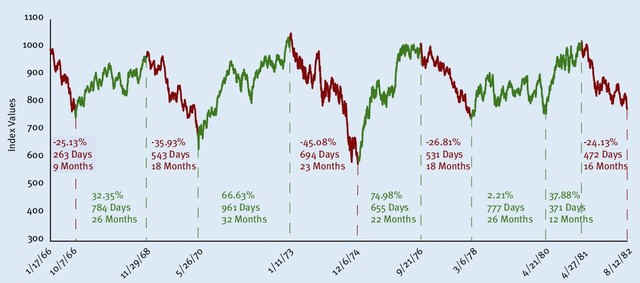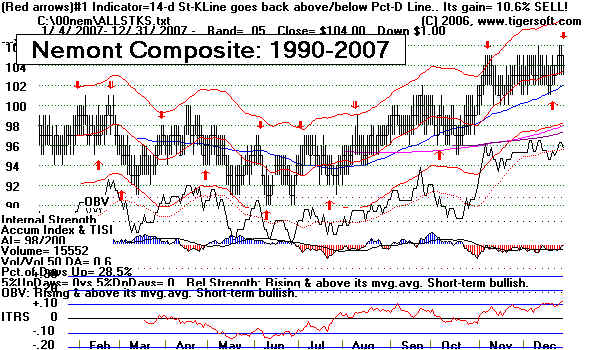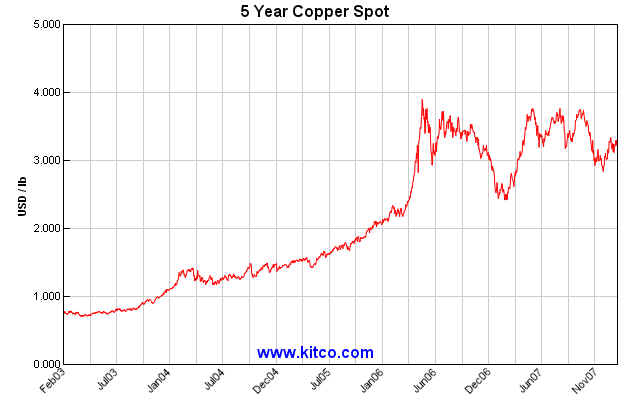The Limits of Monetary Policy: Is Stagflation Coming?
Monetarists like Bernacke are betting that lower interest rates can stimulate
business
and reduce unemployment. The trade-off is that inflation becomes a problem
theoretically if the economy becomes too over-stimulated. "Stagflation" is
a term
describing
the worst of all worlds: high unemployment and rising prices. The term,
is
attributed to Iain MacLeod, the British Chancellor of the Exchequer in 1965.
Stagflation
was a
significant problem in the US in the 1970s. Commodity and fuel prices rose
sharply but
so did unemployment. The cure that was engineered at the time was very
high
interest rates under Paul Volcker's stay as Federal reserve Chairman.
We need to watch carefully now to see if inflation heats up, as it seems to be,
and
unemployment rises, too. That would mean we have re-entered a period of
Stagflation. And if this happens, it will dramatically effect the stock
market. We will see
many more
violent swings ups and downs. The 1970s will be re-visited. And there
will be
increasing calls for much higher interest rates.
---------------------------------- DJI - 1966 to 1982
----------------------------------------------------------------

Greenspan, a Monetarist, had to lower rates 13 times and drop the Discount
Rate to
3/4% to get the stock market and the economy to recover. The Discount Rate
gives big
commercial banks money more cheaply, but there is no guarantee that
businesses
will borrow more just because money is cheaper. There is no guarantee
the those
same banks will pass along their lower rates. Presently, we see now that
banks have
seriously tightened their lending standards, not loosened them. And there
is no
guarantee that money won't be borrowed in the US to buy government bonds
elsewhere
where interest rates are higher.
To
have a positive impact on the US economy, Greenspan had to drop rates
to less
than 1%. But this much drop spawned a housing bubble and sent the US Dollar
spiraling
down. These have been costly problems. A Keynesian would argue that
public
spending on
American infrastructure should have been undertaken, rather than Iraq's.
This
immediately boosts employment, consumption and GNP. Keynesians would
point out
that Bush's tax cuts would have been more a stimulative if they had
gone to
working class people and not the wealthiest. Average income people spend
nearly 100%
of any tax cut they get while the wealthy save it.
President Jimmy Carter's Biggest Regret

(Source: http://www.ibdeditorials.com/IBDArticles.aspx?id=264727202278115
)
Fed Chairman Paul "Volker dealt with stagflation by dramatically jacking up interest
rates, sending the economy into a tailspin. U.S. companies laid off thousands of workers,
and wages came under serious pressure (precisely the point of interest-rate hikes).Meanwhile,
U.S. policymakers began a campaign to open foreign labor markets to U.S. firms, using high
debt levels in "developing countries" as a lever.
As Southeast Asian and Latin American economies opened to U.S. capital, U.S. companies
began to shift operations overseas to take advantage of cheaper labor. That effect, too,
put serious pressure on U.S. wages.
As U.S. workers lost leverage, the labor movement -- so strong through most of the
post-war era -- went belly-up in the 1980s, and remains on the mat today.
Thus Volker fought inflation by directly attacking wages -- and won.
Meanwhile, oil prices declined steeply after their 1980 peak, also aiding Volker's war
on inflation. (They stayed generally low until the late 1990s, when a jump in demand from
China and India -- source of so many products enjoyed by U.S. consumers -- began to push
oil prices up.)
As wages stagnated and the economy shifted from manufacturing-based to services-based,
the U.S. began to grow briskly again. Stagflation had been
defeated.
Workers got the shaft, but they also won two bonuses: One was cheap oil. The other was
ever-cheaper stuff from Latin America, Southeast Asia, and eventually, China."
(Source: http://gristmill.grist.org/story/2007/9/13/164211/215
)
Volcker's Fed also elicited the strongest political attacks and most wide-spread protests
in the history of the Federal Reserve (unlike any protests experienced since 1922) due to
the effects of the high interest rates on the construction and farming sectors,
culminating in indebted farmers driving their tractors onto C Street and blockading the Eccles
Building.[3
(Source: http://en.wikipedia.org/wiki/Paul_Volcker
)
See - Shull, Bernard. 2005. The Fourth Branch: The Federal Reserve's
Unlikely Rise To Power And Influence. Praeger/Greenwood. |

Fed Chariman Paul Volker, August 1979-August 1987.982
Discount Rate:
Period in Effect
Percent
| 11/22/76 to 08/29/77 |
5.25 |
|
| 08/30/77 to 10/25/77 |
5.75 |
|
| 10/26/77 to 01/09/78 |
6.00 |
|
| 01/10/78 to 05/10/78 |
6.50 |
|
| 05/11/78 to 07/02/78 |
7.00 |
|
| 07/03/78 to 08/20/78 |
7.25 |
|
| 08/21/78 to 09/21/78 |
7.75 |
|
| 09/22/78 to 10/15/78 |
8.00 |
|
| 10/16/78 to 10/31/78 |
8.50 |
|
| 11/01/78 to 07/19/79 |
9.50 |
|
| 07/20/79 to 08/16/79 |
10.00 |
|
| 08/17/79 to 09/18/79 |
10.50 |
|
| 09/19/79 to 10/07/79 |
11.00 |
|
| 10/08/79 to 02/14/80 |
12.00 |
|
| 02/15/80 to 03/16/80 |
13.00 |
|
| 03/17/80 to 05/06/80 |
13.00 |
|
| 05/07/80 to 05/28/80 |
13.00 |
|
| 05/29/80 to 06/12/80 |
12.00 |
|
| 06/13/80 to 07/27/80 |
11.00 |
|
| 07/28/80 to 09/25/80 |
10.00 |
|
| 09/26/80 to 11/16/80 |
11.00 |
|
| 11/17/80 to 12/04/80 |
12.00 |
|
| 12/05/80 to 05/04/81 |
13.00 |
|
| 05/05/81 to 09/21/81 |
14.00 |
|
| 09/22/81 to 10/12/81 |
14.00 |
|
| 10/13/81 to 11/01/81 |
14.00 |
|
| 11/02/81 to 11/16/81 |
13.00 |
|
| 11/17/81 to 12/03/81 |
13.00 |
|
| 12/04/81 to 07/20/82 |
12.00 |
|
|
If Bernacke's super aggressive cutting of interest rates can turn the stock market
and the
economy back up, thereby avoiding a bear market and a recession, lots of Central
Bankers
around the world will follow the lessons he is offering. But if the US Dollar tanks
and
Commodity prices rise very rapidly, causing a sharp rise in inflation at a time of
high
unemployment, then his experiment - and that's what it is - will have failed.
The decline in the dollar has been hastened by the cut in interest rates. Hot
money moves
around the globe in search of the highest return, The Dollar has fallen
about 6%
since last August's rate cut. Imports cost that much more. The Dollar
remains
on a sell
from TigerSoft. But there may be hope. Crude oil prices have fallen since
reach
$100/bar.
As that is such a big part of consumer inflation in the US, it deserves to be
watched
closely.
------------------------------------- US Dollar Is Falling
at An Annualized 11.2% Rate ----------------------------------

---------------------------------- Crude Oil Shows Weakening Internal Strength Indicators
----------------------
Crude Oil is on a TigerSoft well. Its recent highs were not confirmed by
new highs
also being made with OBV, On-Balance-Volume, a measure of aggressive
buying or
selling. In addition, the Tiger Accumulation Index remains in a downtrend.
So, at this
point, the Fed must be pleased that oil prices seem to have peaked and
OPEC is not
raising oil prices much. Normally, we would worry that a declining
Dollar
invited OPEC to cut production to raise oil prices to make up for the declining
Dollar.

----------------------------------------
Gold Keeps Making New Highs ------------------------------------------
Speculators bet against the US Dollar by buying Gold. In that, they show their
contempt
for "fiat-based currency". And for months, Gold and gold stocks have
have
been a
superb investment. Now there is some subsidence. But it may be just
temporary.
Mid Summer usually is the best time to buy a Gold Stock. Below is the
TigerSoft
composite Seasonality Chart of gold stock NEM from 1990 to 2007.
----------------------------------- GOLD STOCK SEASONALITY CHART
------------------------------------
(Charts like these are constructed for $150 at your request. Contact TigerSoft.)

Watch to see if Gold (below) holds above its black 21-day ma. Just as
$100 acted
as a magnet for
Crude Oil, $1000/ounce gold seems be a logical target.

-------------------------------------------- Silver Is Strong, Too.
-------------------------------------------------------

------------------------ Copper - An Industrial Commodity
----------------------------------------------
Copper is used extensively in every major industry.

------------------------- DBB - ETF for Base Metals: Copper, Aluminum and Zinc
-----------------
An economic slow-down world wide should bring DBB down.
But the
long-term uptrend of copper look so strong and DBB shows so much
accumulation, it would be surprising to see it fall much below 21.

--------------------------------- Food Commodities Are Rising
Very Fast --------------------------
Food Commodities seem like a very good investment now. And if their
prices continue to rise, the drop in interest rates will be seen as causing a significant
boost to what consumers pay for basic foods. In that case, poorer fixed income
families will be carrying a heavy burden from the Fed's efforts to bail out banks and
brokerages for bad home loans by dropping the Discount Rate. Their strength
is
similar to what was seen in the 1970s.

------------------------------------------ CORN
--------------------------------------------------------

----------------------------------------- COFFEE
--------------------------------------------------------------------

--------------------------------------------- COCOA
-------------------------------------------------------------------

------------------------------------------- SOYBEANS
---------------------------------------------------------------

| PBS Interview with Paul
Volcker PAUL VOLCKER (Former Federal Reserve Chairman, 1979-1987): Inflation is
thought of as a cruel and maybe the cruelest tax, because it hits in an unexpected way, in
an unplanned way, and it hits the people on a fixed income hardest. And there's quite a
lot of evidence, contrary to some earlier thinking, that it hits poorer people more than
richer people.
BEN WATTENBERG:
Difficult times call for difficult actions. So as they say on Wall Street, Volcker slammed
on the brakes.
PAUL VOLCKER: We'll
take the emphasis off of interest rates and put the emphasis on the growth in the money
supply, which is at the root cause of inflation; too much money chasing too few goods in
the old proverbial way of putting the inflationary process. So we'll attack the
too-much-money part of the equation and we will stop permitting supply from increasing as
rapidly as it was.
BEN WATTENBERG: So
Volcker's Fed sold bonds. Less money in circulation pushed interest rates up to 19 percent
in 1981. That plunged America into its deepest economic downturn since the Great
Depression.
PAUL VOLCKER: I
would get asked the question a lot about "How can you conduct a policy that appears
to throw people out of work, anyway?" But I also felt that in the long run, there
wasn't any question that the economy was going to operate better in the context of price
stability.
BEN WATTENBERG: The
recession was painful, but inflation declined from its high of 13.5 percent in 1980 to 1.9
percent in 1986, and remained low and fairly level throughout the 1990s. Since 1983,
America has produced positive economic growth in 67 out of 71 quarters. This prosperous
economy helped set the stock market on a vigorous bull run.
Since 1981, the Dow Jones
Industrial Average has increased from 875 to more than 10,000. New investors poured into
the hot market, encouraged by the advent of IRAs, Keoughs and 401(k)s. By the end of the
century, America had become a nation of owners. A majority of Americans, 52 percent, owned
stocks.
(Source: http://www.pbs.org/fmc/segments/progseg14.htm
) |
THE CURRENT US DEFICIT IS:
U.S. NATIONAL DEBT CLOCK

The Outstanding Public Debt as of 20 Sep 2007 at 05:58:13 PM GMT is:
The estimated population of the United States is 303,037,971
so each citizen's share of this debt is $29,740.81.
The National Debt has continued to increase an average of
$1.42 billion per day since September 29, 2006!
Volker Endorses Obama!
"After 30 years in government, serving under five Presidents of both parties and
chairing two non-partisan commissions on the Public Service, I have been reluctant to
engage in political campaigns. The time has come to overcome that reluctance," Mr.
Volcker said in a statement today. "However, it is not the current turmoil in markets
or the economic uncertainties that have impelled my decision. Rather, it is the breadth
and depth of challenges that face our nation at home and abroad. Those challenges demand a
new leadership and a fresh approach."
He concluded: "It is only Barack Obama, in his person, in his ideas, in his
ability to understand and to articulate both our needs and our hopes that provide the
potential for strong and fresh leadership. That leadership must begin here in America but
it can also restore needed confidence in our vision, our strength, and our purposes right
around the world."
|
Next in the Series on Monetarists versus
Keynesians - This Coming Weekend.
What is the real level of employment?
|


















